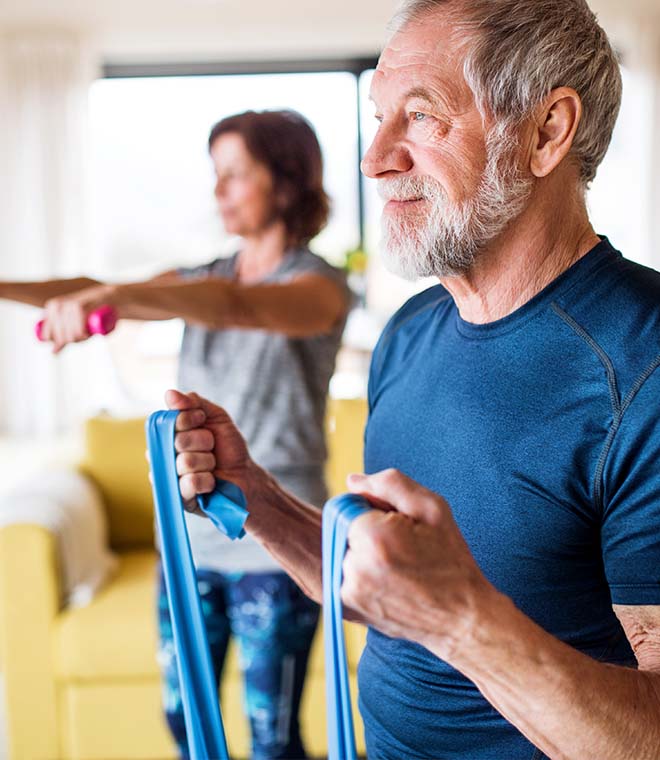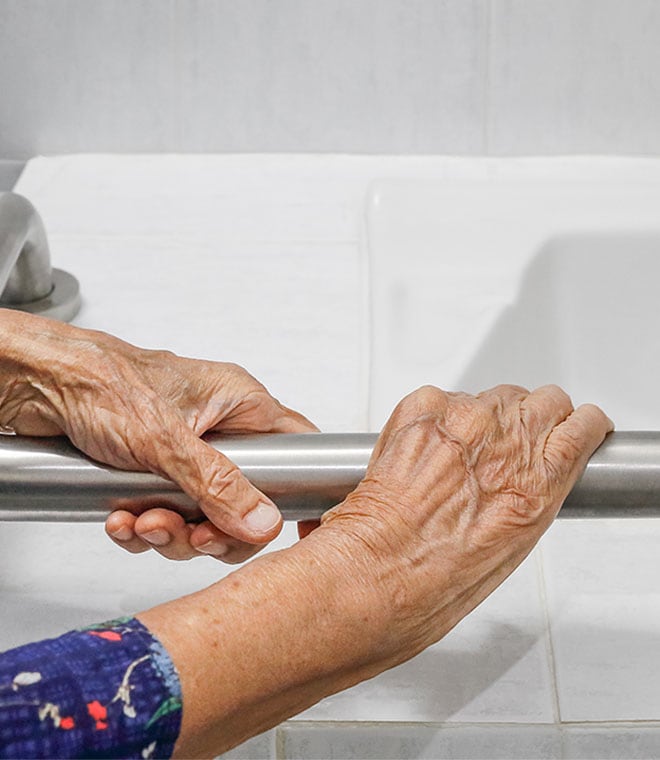Wellness
Mobility devices: Exploring options for your loved one
By Walgreens Jun 16, 2022 • 15 min
When a loved one begins to have trouble with mobility, everyday activities and simple outings can suddenly become difficult.
Fortunately, there are many mobility devices available to help people remain more independent. Read on to learn more about commonly used mobility aids.
Walkers and rollators
There are many types of walkers. The most common walkers are the standard, the two-wheeler and the rollator walkers.
A standard walker has a folding metal frame with four nonskid, rubber- tipped legs. To use a traditional walker, your loved one will need to lift the walker, move it forward and then step toward it.
Two-wheel walkers have two front wheels, so the individual using it does not have to pick up the walker to move forward.
A rollator walker is a walker with 3 or 4 wheels. With these rolling walkers, users simply push the frame along as they walk. There is no need to lift a rollator walker.
As a result, two-wheel walkers or rollators may be a better type of walker for seniors who have limited arm strength. However, there are many other factors that need to be considered when selecting a suitable mobility device. Make sure your loved one seeks the advice from a healthcare professional and receives instruction on proper use.
Most walkers fold for portability and are height adjustable. Walkers can be used in a wide range of settings. You can even purchase specialty pool walker mobility aids for seniors who would like to move independently in swimming pools.
Benefits
Rollators and walkers can make it easier for individuals with mobility issues to get around by providing stability and balance support. Because of their lightweight, folding design, traditional and roller walker mobility aids are easy to travel with. Most Walgreens walkers are height adjustable, so they can be used by individuals of a wide range of heights.
Considerations
Some individuals may not be able to grip a walker for long periods of time or worry about how they will carry items while using a walker or rollator. To address the problem, some rollator models and walkers come with walker accessories that can hold personal belongings on the go. You can also purchase walker trays, walker bag pouches and walker basket accessories to add on to walkers. Walkers with padded seats can help people who become fatigued easily.
Wheelchairs and transport chairs
Wheelchairs are mobility aids that feature a frame mounted on wheels. There are a number of types available:
Traditional manual wheelchairs have small front wheels and large back wheels that the user can grip to move themselves forward and backward. Many models are folding wheelchairs that can be taken with you on the go.
Wheelchairs also come in a variety of specialty styles and sizes.
Pediatric wheelchair models are designed for children.
Bariatric wheelchairs have a larger seat and a higher weight capacity than traditional wheelchairs, making them ideal for larger people.
Reclining wheelchairs have adjustable backs that allow users to sit in a more relaxed position.
Standing wheelchairs allow users to rise from a seated to a standing position as needed.
A shower wheelchair has a more compact design and is made of rustproof and waterproof materials. Some shower wheelchairs also come with a removable commode.
Transport or transporter chairs have four small wheels. A transporter wheelchair is designed to be pushed by a caregiver rather than the user. Many models are folding, portable wheelchairs that can be used while traveling.
Electric wheelchairs have a built-in motor the user usually controls with their hands. Unlike manual wheelchairs, a motorized wheelchair model does not need to be pushed. The user sitting in the chair can simply tap a button or use a joystick-type control to move the chair. Although these wheelchairs often fold, some models may be bulkier and heavier than manual models, making them less than ideal for individuals who are looking for lightweight wheelchairs for occasional use. Access vans with a wheelchair lift can make it easier to travel with a power wheelchair.
Benefits
With many styles available, there are options to fit many needs and budgets. Wheelchair accessories like a wheelchair basket or wheelchair bag make it easy for users to carry items. Manual wheelchairs also allow for some physical activity to help those with limited mobility get some exercise.
Considerations
Manual and power wheelchairs are less than ideal for people who have difficulty sitting comfortably for long periods of time. A wheelchair cushion or pad can help individuals find a more comfortable position.
Wheelchairs cannot travel up and down stairs. Users may need wheelchair ramps or wheelchair lifts to enter some buildings or move safely through their homes. A portable wheelchair ramp can be purchased for navigating small flights of stairs, such as steps leading up to a front door. A wheelchair lift can be installed in multiple-story homes to help individuals who use wheelchairs reach higher or lower floors.
Canes
A cane is a mobility device that consists of a long post and a handle. There are three main types available:
Single-point canes have one tip that comes in contact with the floor. These are the most common types of walking canes.
Multi-point canes have four cane tips at the bottom. This type of cane, commonly referred to as a quad cane, provides a larger base of support.
Bed canes are handles that attach to the side of a bed. A bed cane may be used for those who need assistance getting in and out of bed. It is not used for walking.
Benefits
Canes can help improve balance during walking or compensate for an injury or disability so that it's easier to get around. Lightweight canes are very easy to travel with. You can even purchase folding canes that are small enough to tuck away in a travel bag. Today, walking canes for men and women come in a wide range of colors and designs to function as fashion accessories as well as mobility aids.
Considerations
Canes only provide support to one side of your body. Contrary to what you might think, it's important to use the cane on the stronger side of your body. For example, if you have weakness on your right side, use the cane on your left side. It can take time for users to learn how to walk with a cane. If you don't use it the right way, a cane may increase your risk of falling. A physical therapist can help you use your cane correctly. Walking with a cane is also not as stable as walking with a walker. As a result, those who are very unsteady on their feet may not be able to use a cane. As with walkers, using canes can lead to fatigue during long outings. You can find walking canes with seats to help address this problem. In addition to canes with seats, there are also models available with storage bags for carrying items on the go.
Crutches
Crutches are mobility aids that keep weight off one foot. There are three main types available:
Underarm crutches are designed to be placed under the arms. They have long metal or wooden frames with tips on the bottom. Usually, underarm crutches are intended for short-term use for lower extremity injuries or weakness. These crutches need to be fitted to your height. Using just one crutch is not recommended.
Forearm crutches have semicircular tops that fit around the forearms with handles below. These crutches take pressure off of the underarm area and are normally recommended for individuals who will be using crutches for a long period of time.
Knee crutches are a single crutch with a platform for the knee positioned on a post. Also called a hands-free crutch or a knee walker, a knee crutch supports the injured or weak lower limb when the user walks. You can also find knee scooter models that have wheels on the bottom that allow it to roll along with the user.
Benefits
Crutches, when properly fitted, provide extra stability for walking. They can help people recover from leg or foot injuries, such as a fracture, sprain or strain by reducing the amount of weight placed on the affected lower extremity. Crutches must be height adjusted to suit the needs of different users.
Considerations
Crutches are intended for individuals who are steady on their feet but are required to reduce weight load on one or both legs. As a result, they are not the best choice for seniors with limited mobility. Crutches also require good arm, shoulder and hand strength to stay upright. It takes a little practice to learn how to use crutches. Some people also find it uncomfortable to use crutches for long periods of time; however, crutch padding can be purchased to cushion the frame and ease discomfort.
Lift chairs
Typically, lift chairs are designed to help a user get into a standing or seated position safely. Lift chair recliners are chairs that lift the user up and tilt forward, making it easier for people with limited mobility to stand up and sit down. Lifting recliner chairs may have other features like massage and heat to ease pain and stiffness. Most electric lift chair recliners look like an ordinary piece of furniture. You can find options with many different types of upholstery to match your decor.
Benefits
A power lift chair can help individuals get into and out of a seat more independently at home.
Considerations
The primary drawback to a reclining electric lift chair is that electricity is needed to power the device. Some models feature a battery back-up that allows the motors to operate even in the event of a blackout.
Scooters
Motorized scooters consist of a chair mounted on a three- or four-wheel frame. A handle is positioned on the front. Users simply press buttons or push a joystick to move forward and backward.
Benefits
Motorized scooters allow users to move independently without exerting as much physical effort as they would with a manual wheelchair. Motorized scooters for adults, unlike some wheelchairs, can travel over uneven terrain with ease. As a result, many people prefer motorized scooters for outdoor activities. Most models include scooter accessories, like baskets or bins for storing personal items.
Considerations
Some motorized scooters are large in size and cannot easily navigate through or turn around in tight spaces. Scooters can only travel for a set number of miles before the batteries need to be charged or replaced. Some scooters have removable batteries, so you can carry spares with you for longer trips. Some people may not be able to comfortably or safely sit on the seat of an adult electric scooter. Also, motorized scooters with seats are heavy, which can pose challenges with traveling or transport. However, many scooters can be disassembled for easier traveling.
To help decide whether an adult walker, a manual or power wheelchair, a foldable cane or an electric scooter is the right choice for your loved one, talk with your healthcare provider or physical therapist. Together, you can find the best solution to keep your loved one moving as safely and independently as possible. A mobility aid should also be routinely evaluated by a healthcare professional to ensure proper height and fit, and to make sure the device is maintained and used correctly.
Clinically reviewed and updated by Nancy Kupka, PhD, RN, June 2022.



